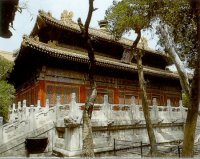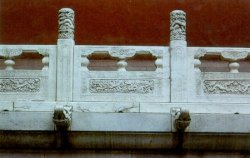

![]()
Hall of Imperial Peace

Figure 3.1: Hall of Imperial Peace
Click on the image to enlarge it
Architecture Information
| Click on the image to enlarge it | |
 Figure 3.2: Hornless Dragon-shaped Head |
 Figure 3.3: Marble Balustrades |
The roof of the Hall of Imperial Peace is
�flat-topped and hipped and surmounted by a large gilt roof pommel� (Ru
130). The corner of the hall was
decorated by the hornless dragon-shaped head, as shown in figure 3.2.
There are steps on the side and a ramp in the middle to the hall.
The ramp was carved with dragons and clouds.
The hall was built on a Sumeru stone terrace and was surrounded by marble
balustrades curving with dragons and phoenix, as shown in figure 3.3 (Yu 196).
The capitals were carved with phoenixes and clouds.
However, the capital of the corner post is different.
It was carved with dragon and clouds instead, as shown in figure 3.4. There
is a low wall on four sides of the hall. It symbolizes that the building is �self contained� (Yu
196). Inside the hall, the statue
of the God of Black was located in the center, as shown in figure 3.5.
Detail
The Chinese emperor Jia Jing in the Ming Dynasty built the Hall of Imperial Peace in the Forbidden City. The Hall of Imperial Peace is a Taoist hall. It is located in the north of the Imperial Garden. It is a place for worshipping the Supreme Deity of the Taoist religion (Yu 196). The God of Black or God of North, which is also known as the God of Water, was worshipped in the hall (Ru 120). As a result, Jia Jing brought Taoism and the God of Black to the Forbidden City because the Forbidden City only had Buddhist buildings before the construction of the Hall of Imperial Peace in the Ming Dynasty. He also introduced the God of Black to his family: his wife and concubines worshipped the God of Black. The Chinese empress and concubines burned sticks of incense or red candles on the two monthly holidays of the moon calendar if they hoped the god would fulfill their wishes (Dorn 158). Moreover, the Hall of Imperial Peace was used not only by empresses and concubines but also by the whole imperial family because the Taoist assemblies were held in the Hall of Imperial Peace during the Ming and the Ching Dynasty (Yu 196).
![]()
Home Background Map Religion Libraries Theaters Conclusion Bibliography
Created by May Wong